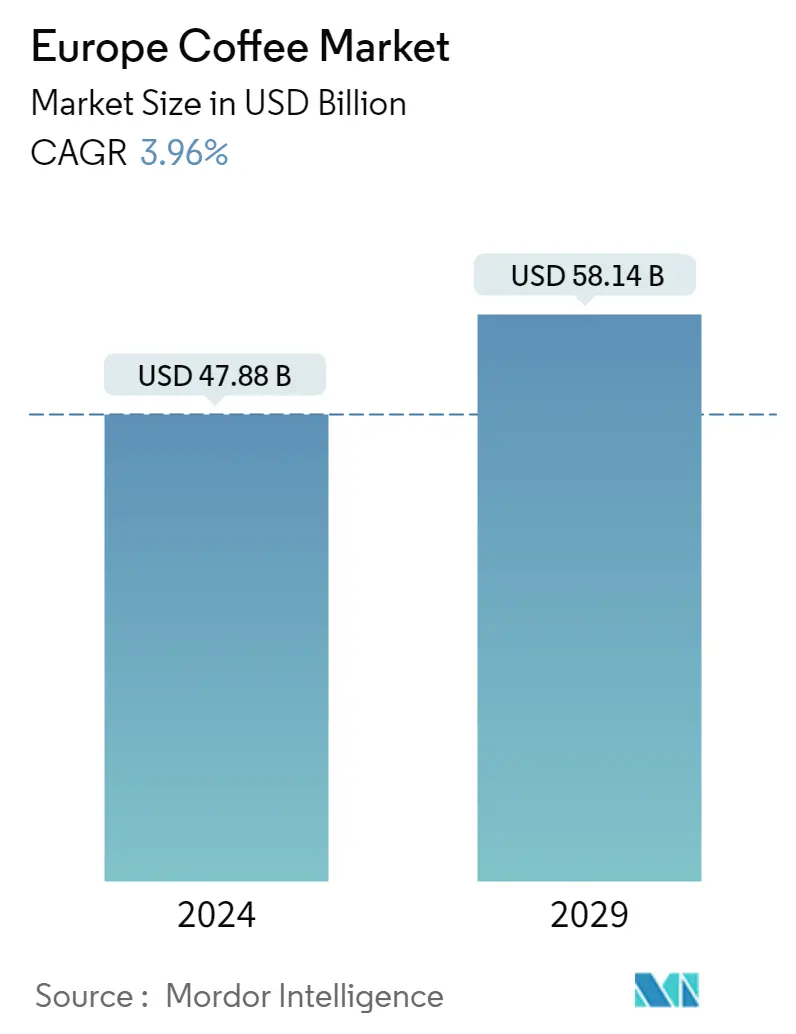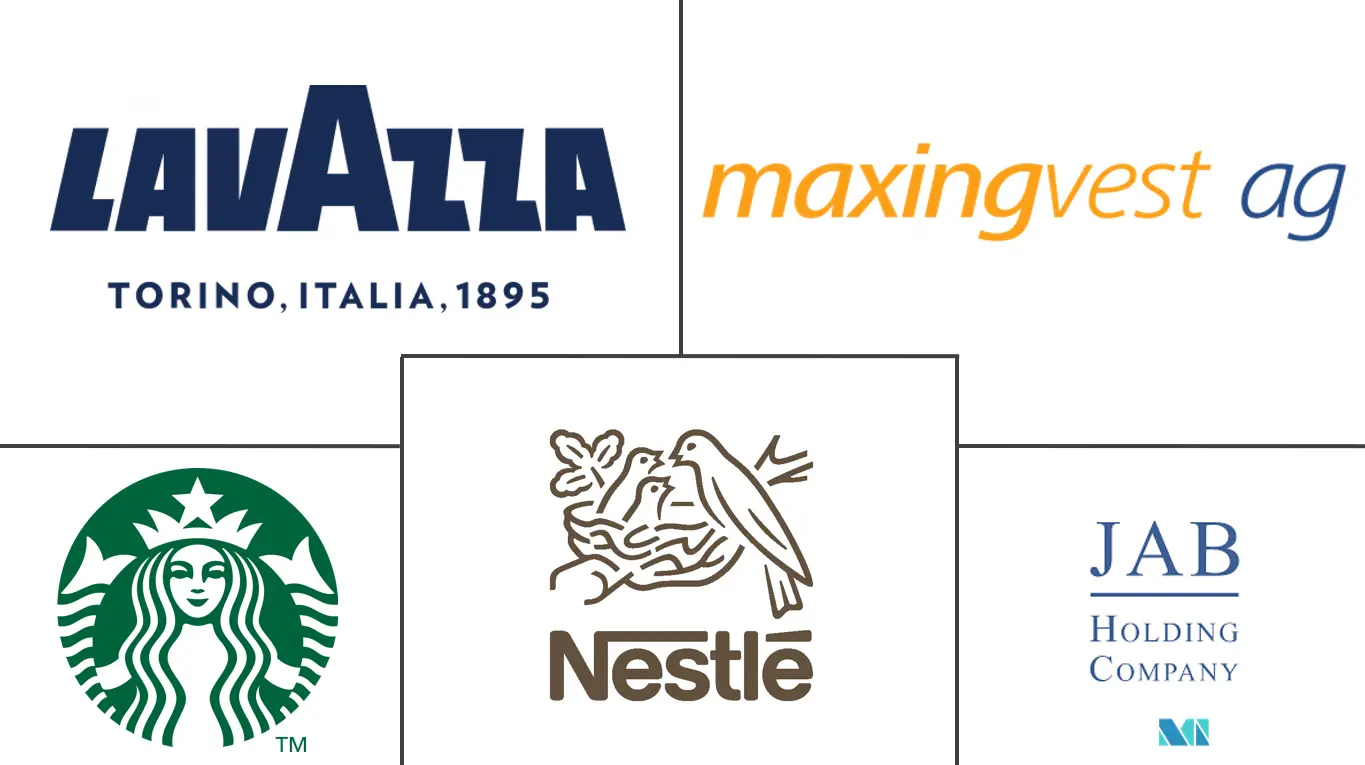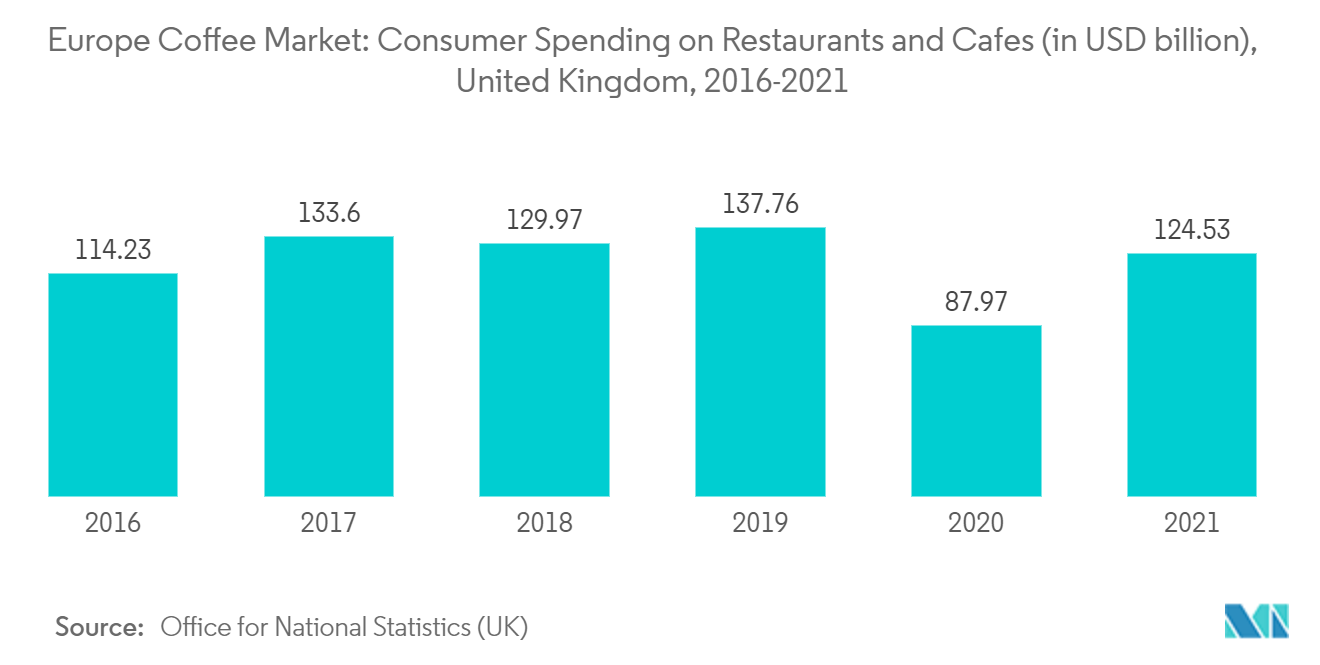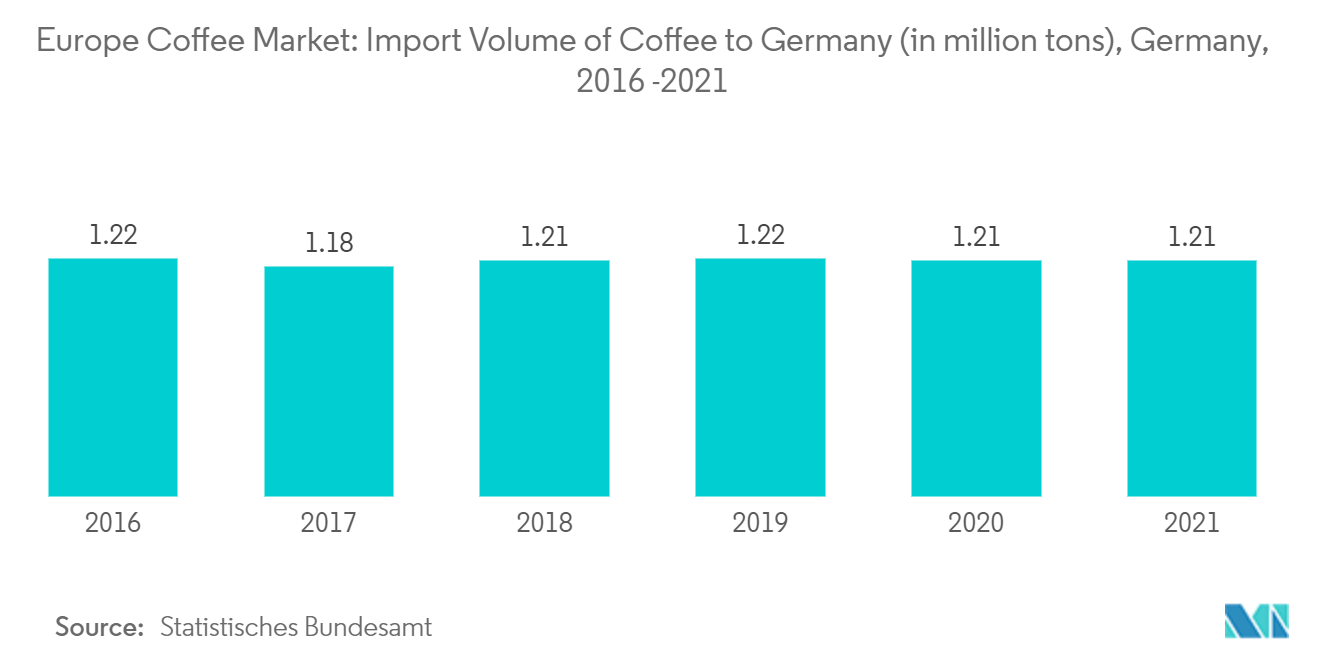Europe Coffee Market Size

| Study Period | 2018 - 2029 |
| Base Year For Estimation | 2023 |
| Market Size (2024) | USD 47.88 Billion |
| Market Size (2029) | USD 58.14 Billion |
| CAGR (2024 - 2029) | 3.96 % |
| Market Concentration | High |
Major Players
*Disclaimer: Major Players sorted in no particular order |
Europe Coffee Market Analysis
The Europe Coffee Market size is estimated at USD 47.88 billion in 2024, and is expected to reach USD 58.14 billion by 2029, growing at a CAGR of 3.96% during the forecast period (2024-2029).
According to the European Coffee Federation, Europe accounts for around 33% of all coffee consumed worldwide in 2020/21, which makes it a significant and attractive market for coffee. The European Union also has the highest per capita consumption of coffee in the world, even though their consumption varies from country to country. Coffee is considered to be one of the most popular drinks in Western Europe due to its deeply ingrained culture and widespread use in the daily routine of consumers. Additionally, the demand for coffee is also increasing in the region due to the number of new coffee shops opening, the growth of coffee chain stores, and the increasing number of people buying coffee machines. According to Project Café Europe 2022, the European coffee chain market grew by 3.2% during the past year to reach 40,675 outlets.
The European coffee market is driven by multiple factors, such as the increasing demand for certified coffee products, acceptance of single-serve coffee brew systems by consumers, and constant innovation led by the top players in the coffee market. However, the changing weather conditions play a crucial role in coffee production in countries where production takes place, affecting the supply chain of coffee being imported into European countries.
The premiumization of whole-bean coffee products is driving the coffee market. Major players in the market are trying their best to introduce premium products by utilizing artisanal techniques or using the handpick method to get a premium product, which is increasing the demand for coffee in the region, hence boosting the growth of the market studied in the region.
Europe Coffee Market Trends
This section covers the major market trends shaping the Europe Coffee Market according to our research experts:
Consumer Preference for Premium Coffee Fuels Growth in Specialty Coffee Shops Market
The sharp growth in the premium coffee market has been partly driven by the continuous growth of out-of-home consumption. Coffee shops in European countries are leading the way by introducing sophisticated, high-value varieties to consumers, thereby boosting market growth significantly. The growing demand for premium coffee is in line with growing consumer interest in how the coffee is brewed, as well as how the crop is grown. It has, therefore, become essential for specialty coffee producers to tell the story behind their coffee, its origin, and its other environmental and social aspects.
In recent years, coffee in the United Kingdom has become reliant on coffee shop-driven premiumization. Over the last decade, consumers who had been witnessing rising incomes learned about value-added approaches to coffee at coffee shops. Thus, there was an increased appreciation for premium coffee in other food service and retail occasions. Further, the origin of coffee is receiving increasing attention from the industry and consumers in the premium category. Single-origin coffee is associated with high quality and uniqueness from a certain region or country. At Starbucks, the world's largest coffee chain, single-origin coffee has also started to gain space.

Germany Holds a Significant Share in the Coffee Market
Europe has minimal coffee production, and Germany is one of the coffee-producing countries in the region. As per the data published by the Centre for the Promotion of Imports Ministry of Foreign Affairs, an increasing number of Germans are consuming coffee at their homes, coffee shops, and cafes, leading to growth in the on-trade market segment in Germany. This is increasing the application of various coffee products in the country. According to Kaffeeverband, a German coffee organization, in 2021, the per capita consumption of coffee rose from 168 liters to 169 liters, a corresponding 500 million more cups (compared to 2020).
Coffee consumption at work is of great prominence in Germany. Germany is the largest importer of green coffee beans in Europe. The German coffee roasting industry has grown to be one of the most significant in the world, serving both its domestic market - the largest in Europe - as well as its export markets. For the German coffee market, sustainability has become a minimum requirement for entry. In recent years, specialty coffee has taken over a larger share of the market. Germany imports the greenest coffee beans in Europe. As per Eurostat, in 2021, Germany accounted for 34% of direct European imports from producing countries, totaling approximately 1.1 million tonnes worth USD 3.51 billion. The increasing demand for freshly brewed coffee is pushing companies to opt for roasted whole beans, thereby reducing the sales of roasted ground coffee in the country.

Europe Coffee Industry Overview
Some of the most active companies operating in the market studied are Starbucks Corporation, Tchibo GmbH, Strauss Group Ltd, Nestle SA, Luigi Lavazza SPA, and JAB Holdings. Companies such as Nestle SA have expanded their production capacity by creating new manufacturing units to capture market share and introducing new varieties of coffee for buyers. Companies are making investments in developing new Nespresso machines and Grand Cru coffee, including unique coffee varieties from rare origins. Furthermore, the companies actively invest in online distribution channels, targeting consumers seeking convenience. The ease of use of these products provides a premium flavor to coffee. Good marketing by the key players and the wide variety of flavors have contributed to their increasing popularity in European countries.
Europe Coffee Market Leaders
-
Starbucks Corporation
-
JAB Holding Company
-
Nestlé S.A.
-
Maxingvest AG (Tchibo)
-
Luigi Lavazza S.p.A.
*Disclaimer: Major Players sorted in no particular order

Europe Coffee Market News
- November 2022: Nescafé Dolce Gusto unveiled its next-generation coffee pods and machines, referred to as Neo. Nestlé's new coffee pods use 70% less packaging than current capsules (by weight) and are paper-based and compostable. Nestlé's Swiss R&D Center for Systems has refined this product over the past five years.
- May 2022: Melitta and OFI partnered to provide consumers with traceable and differentiated coffee. OFI (Olam Food Ingredients) and Melitta Europa GmbH & Co. KG - Coffee Division use blockchain technology and other digital tools to track coffee from farm to roaster and meet growing consumer demand.
- December 2021: Starbucks introduced its new oat dairy alternative coffee in its espresso segment. It includes three combinations of flavors, Vanilla & Strawberry, Hazelnut & Honey, and Dark Cocoa & Orange, uniquely handcrafted to enhance a distinctive flavor. It announced its plan to not charge extra for dairy-alternative products from January 2022.
Europe Coffee Market Report - Table of Contents
1. INTRODUCTION
- 1.1 Study Assumptions and Market Definition
- 1.2 Scope of the Study
2. RESEARCH METHODOLOGY
3. EXECUTIVE SUMMARY
4. MARKET DYNAMICS
- 4.1 Market Drivers
- 4.2 Market Restraints
-
4.3 Porter's Five Forces Analysis
- 4.3.1 Threat of New Entrants
- 4.3.2 Bargaining Power of Buyers/Consumers
- 4.3.3 Bargaining Power of Suppliers
- 4.3.4 Threat of Substitute Products
- 4.3.5 Intensity of Competitive Rivalry
5. MARKET SEGMENTATION
-
5.1 By Product Type
- 5.1.1 Whole Bean
- 5.1.2 Ground Coffee
- 5.1.3 Instant Coffee
- 5.1.4 Coffee Pods and Capsules
-
5.2 By Distribution Channel
- 5.2.1 On-trade
- 5.2.2 Off-trade
- 5.2.2.1 Supermarkets/Hypermarkets
- 5.2.2.2 Convenience Stores
- 5.2.2.3 Specialist Retailers
- 5.2.2.4 Other Off-trade Channels
-
5.3 By Geography
- 5.3.1 United Kingdom
- 5.3.2 Germany
- 5.3.3 France
- 5.3.4 Russia
- 5.3.5 Italy
- 5.3.6 Spain
- 5.3.7 Rest of Europe
6. COMPETITIVE LANDSCAPE
- 6.1 Most Adopted Strategies
- 6.2 Market Share Analysis
-
6.3 Company Profiles
- 6.3.1 JAB Holding Company
- 6.3.2 Nestlé SA
- 6.3.3 The Kraft Heinz Company
- 6.3.4 J.J. Darboven GmbH & Co. KG
- 6.3.5 Strauss Group Ltd
- 6.3.6 Melitta Group
- 6.3.7 Starbucks Corporation
- 6.3.8 Krüger GmbH & Co. KG
- 6.3.9 Luigi Lavazza SpA
- 6.3.10 Maxingvest AG (Tchibo)
- *List Not Exhaustive
7. MARKET OPPORTUNITIES AND FUTURE TRENDS
** Subject To AvailablityEurope Coffee Industry Segmentation
Coffee is a brewed drink prepared from roasted coffee beans, the seeds of berries from certain coffee species.
The European coffee market is segmented by product type, distribution channel, and geography. By product type, the market is segmented into whole bean, ground coffee, instant coffee, and coffee pods and capsules. By distribution channel, the market is segmented into on-trade and off-trade distribution channels. The off-trade channel is further segmented into convenience stores, specialist retailers, supermarkets/hypermarkets, and other distribution channels. By geography, the market studied is segmented into France, Germany, the United Kingdom, Spain, Italy, Russia, and the Rest of Europe. For each segment, the market sizing and forecasts have been done on the basis of value (in USD billion).
| By Product Type | Whole Bean | |
| Ground Coffee | ||
| Instant Coffee | ||
| Coffee Pods and Capsules | ||
| By Distribution Channel | On-trade | |
| Off-trade | Supermarkets/Hypermarkets | |
| Convenience Stores | ||
| Specialist Retailers | ||
| Other Off-trade Channels | ||
| By Geography | United Kingdom | |
| Germany | ||
| France | ||
| Russia | ||
| Italy | ||
| Spain | ||
| Rest of Europe |
Europe Coffee Market Research FAQs
How big is the Europe Coffee Market?
The Europe Coffee Market size is expected to reach USD 47.88 billion in 2024 and grow at a CAGR of 3.96% to reach USD 58.14 billion by 2029.
What is the current Europe Coffee Market size?
In 2024, the Europe Coffee Market size is expected to reach USD 47.88 billion.
Who are the key players in Europe Coffee Market?
Starbucks Corporation, JAB Holding Company, Nestlé S.A., Maxingvest AG (Tchibo) and Luigi Lavazza S.p.A. are the major companies operating in the Europe Coffee Market.
What years does this Europe Coffee Market cover, and what was the market size in 2023?
In 2023, the Europe Coffee Market size was estimated at USD 46.06 billion. The report covers the Europe Coffee Market historical market size for years: 2018, 2019, 2020, 2021, 2022 and 2023. The report also forecasts the Europe Coffee Market size for years: 2024, 2025, 2026, 2027, 2028 and 2029.
What are the challenges faced by the European Coffee Industry due to climate change and potential disruptions in bean supply?
The challenges faced by the European Coffee Industry due to climate change and potential disruptions in bean supply are a) Potential impact on coffee bean quality b) Production costs c) Potential adaptation strategies
Coffee in Europe Industry Report
The European coffee market showcases robust growth and diversity, becoming a global consumption hub with a surge in coffee shops and a tilt towards premium and specialty coffees. Driven by the younger generation's embrace of cafe culture, influenced by urbanization and economic uplift, the market thrives on a variety that includes single-origin and certified products. A significant trend towards eco-friendly and sustainable practices is evident, with certifications like Fair-Trade, Rainforest Alliance, and UTZ steering consumer choices towards premium, whole-bean, and artisan coffees emphasizing quality and sustainability. Coffee brands in Europe are increasingly focusing on these certified and high-quality offerings to meet the rising consumer demand. Germany stands out as a key player, both as a major consumer and a top importer of organic coffee, highlighting the region's commitment to quality and environmental stewardship. These evolving preferences mark a growing demand for premium, certified, and sustainably sourced coffee products in Europe.
The European coffee market report covers market size, market share, market segmentation, market report, industry worth, industry analysis, market analysis, market trends, industry statistics, market research, target market, industry growth, price trend, industry overview, industry size, market growth, global market, industry report, industry value, market value, market cap, market statistics, industry revenue, market overview, annual report, industry data, industry information, industry outlook, market data, market forecast, market leaders, market outlook, market structure, market update, growth statistics, industry forecast, industry pdf, industry profile, industry research, industry sales, report pdf, revenue statistics, sales data, market reports, analysis example, analysis pdf, analysis report, consumer market, global industry, growth forecast, growth rate, largest companies, market capitalization, market index, market predictions, market review, profile pdf, research company, sales forecast, size global, industry reports, industry trend, industry trends, market segments, market trend, price trends.



